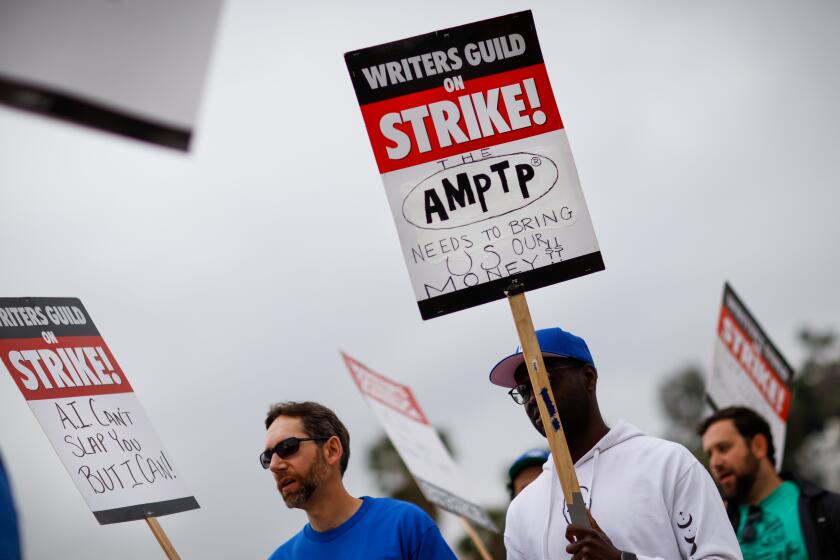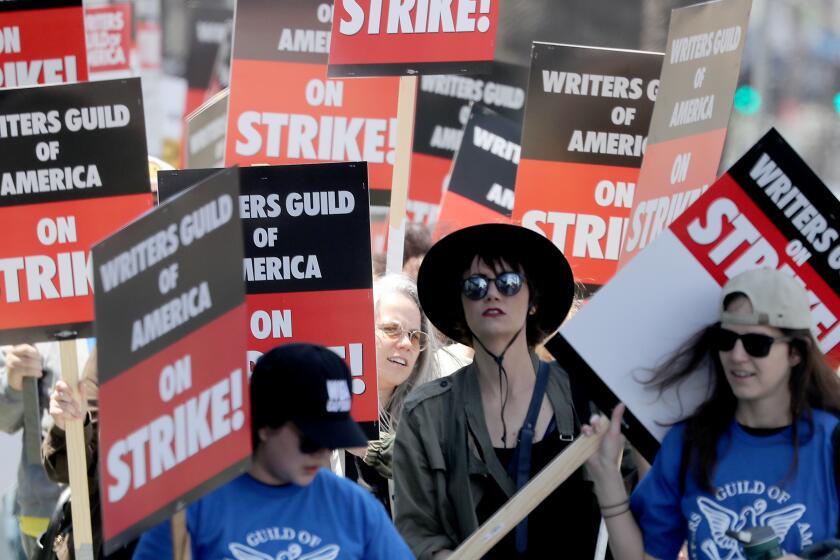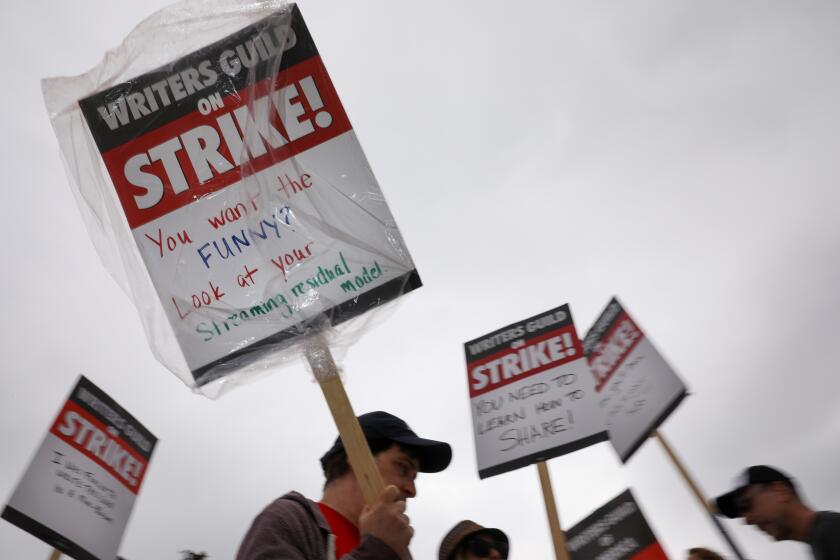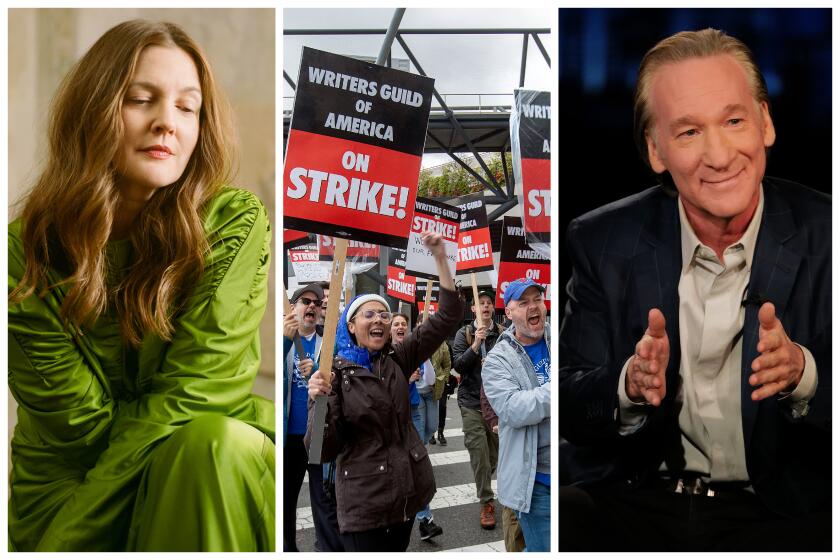Hollywood crew members fight to hang on as the strikes drag on: ‘We’re the collateral damage’

- Share via
Jamie McElrath needs to find a roommate before the end of the month.
A scenic artist who has painted sets for popular shows such as Netflix series “You” and FX’s “What We Do in the Shadows,” McElrath, 38, has been out of work for about five months amid the ongoing writers’ and actors’ strikes.
Her old roommate moved out on Sept. 1 to seek a more affordable life outside of California. His empty room in her Glendale apartment worries her, along with $2,300 in rent. Not to mention the $15,000 in credit card debt that continues to balloon as she struggles to pay for internet, car bills and gas.
“It’s very weird to go from a place where you’re used to making $1,600 to $2,000 a week, and changing your habits of how you buy things, how you eat and how much [gas] you put in your car,” McElrath said. “It almost feels like money is helpless in this moment right now.”
As the SAG-AFTRA and WGA strikes continue, a grief counselor offers a support group to actors and writers grappling with a loss of work and identity.
McElrath is among the thousands of film and TV crew members who have largely been unemployed during the Hollywood work stoppages that began earlier this year over issues around streaming pay, residuals, working conditions and protections against artificial intelligence.
Below-the-line workers include camera operators, light technicians, makeup artists, costume designers, boom mic operators, drivers and other studio laborers.
This week, the Writers Guild of America and the Alliance of Motion Picture and Television Producers resumed negotiations. People close to the talks described the tone of the meeting as positive. Despite the optimism, the strike has passed its 140th day and crew members have expressed frustration over the slow pace of negotiations. Much of their anger is directed toward the AMPTP.

While they aren’t on strike themselves, crew members have been among the hardest hit by shutdowns caused by the twin strikes (actors joined writers on the picket lines in mid-July).
Their reserves were largely depleted during the previous industry shutdowns amid COVID-19, and many have had to dip into their savings, struggling to pay for essentials such as rent, mortgages, food and other costs related to family and children.
While crew members struggle to find work, their healthcare, provided by the International Alliance of Theatrical Stage Employees and the Teamsters union, is beginning to expire. Some are facing eviction.
IATSE spokesperson Jonas Loeb could not immediately comment Friday afternoon when asked about the frustrations and financial burdens of the union’s membership. He instead referred to an oft-repeated quote from an anonymous studio executive who told Deadline in July, “The endgame is to allow things to drag on until union members start losing their apartments and losing their houses.”
The AMPTP said last week that every member of the alliance is committed to “working together with the WGA to end the strike.”
Bodie Hyman, a key grip, and his wife, a yoga instructor, have spent about $40,000 of their savings, mostly to pay for food and the mortgage on their Woodland Hills home, where they are raising their two children.
He said there is work around town, shooting commercials and music videos, which are allowed amid the strikes. But those jobs are rare. Two of his friends, who are also Hollywood workers, have already moved out of Southern California — one moved to Nashville to pursue construction work, while another moved to Pennsylvania where his mom lives.
“The perception is that why would they stay here when there’s no work and their livelihood has turned its back on them?” said Hyman, 48. “It’s a very expensive town to not work in and live in.”
WGA and AMPTP representatives met for the second time this week as the two sides worked on an agreement that would end the writers’ strike.
The nature of work for crew members differs from the rest of Hollywood.
Even before the strike, writers and actors were more accustomed to going long periods between projects, filling the gaps in employment with jobs outside the industry, whether bartending, teaching or driving for ride-share and delivery services. Jobs for crew members, however, tend to be more consistent. Yet when the industry shuts down, they are left to start from scratch.
“We don’t have a lot of opportunities for side hustles and ... our skills are very focused,” said Ray Milazzo, an industry veteran who works as a first assistant camera person.
He described the industry like the military, with everyone contributing a specialty to their individual job. “A lot of our skills aren’t transferable.”
Milazzo, 51, lives in a double-union household — his wife, LaVerne Caracuzzi, is a makeup artist and member of Make-Up Artists & Hair Stylists Guild (IATSE Local 706). She’s been without work since January when “All American: Homecoming” finished shooting. Afterward, talk of a writers’ walkout loomed and projects began to halt. Her unemployment has run out.
Although Milazzo, who lives in Thousand Oaks, has recently found occasional work on commercials, a single paycheck is hardly enough for their family to get by. The couple have had to dip into their savings to cover their mortgage, car bills, college tuition for one of their two kids and other expenses.
Workers in film and TV, most of whom are pro-union, have been trying to make ends meet amid a dual strike of Hollywood actors and writers.
Long-standing industry foundations have stepped in to assist struggling Hollywood workers.
The Motion Picture & Television Fund, which receives donations from local unions, individual donors, studios and streamers, has been giving out $1,500 grants, prioritizing below-the line workers. Since the start of the writers’ strike, the fund says it has assisted roughly 1,400 workers, distributing more than $1.5 million. That number is expected to rise by another half-million dollars in the next several weeks.
Last month, Bob Beitcher, the fund’s president and chief executive, wrote an open letter to the industry, blasting it and the media for overlooking crew workers, whom he referred to as “the backbone of the industry” and “forgotten casualties during these strikes.”
“We needed to raise the flag to the industry and the larger entertainment community. ... They need to remember the crew, who are the lowest paid workers ... we need to support them as well,” Beitcher said of his letter in a recent interview.
He said his foundation receives 150 to 200 calls each day and prioritizes people who have less than $10,000 in liquid assets. He’s heard workers report that they’ve moved back in with their families, many leaving California. Some have given up their dream of working in the industry altogether. Others have lost their homes due to evictions, along with their cars and health insurance. Several applicants are living in Southern California unhoused.
The 2023 writers’ strike is over after the Writers Guild of America and the Alliance of Motion Picture and Television Producers reached a deal.
Keith McNutt, who is the Western region director of the Entertainment Community Fund, another foundation set up to assist entertainment industry workers, said that over the last month they have seen a dramatic increase in people who are facing three-day eviction notices, mortgage foreclosures and utility shutoffs.
His fund has distributed more than $7.1 million in aid to Hollywood workers since the start of the writers’ strike, giving out $400,000 to $500,000 each week.
Major donors within the industry have been pouring funds into the organization, among them showrunners and celebrities such as Seth MacFarlane, who this week donated $5 million. IATSE has already given $4 million to foundations such as the MPTF and the Entertainment Community Fund to help its members. The size of checks to applicants vary depending on need. At times, the fund has been able to stave off eviction for some individuals.
“We hope that what we do puts a plug in the dam for a little bit while they get back on their feet and come up with a plan or a strategy for what to do next month,” McNutt said.
As the strikes continues, he said he’s noticed the severity of people’s needs growing worse.
“The level of economic distress is escalating as time goes on, and that of course brings a parallel process of all of the emotional distress,” McNutt said, adding that his organization offers seminars on financial and mental health support.
SAG-AFTRA has approved a deal from the studios to end its historic strike. The actors were on strike for more than 100 days.

Others in the industry have turned to more unconventional means of survival. Greg Gilday has spent the last five years as an IATSE prop maker. He’s built space ships in galactic worlds featured on “Star Wars” series including “Ahsoka” on Disney+. Now, he spends part of his time rummaging through his garage looking for “Star Wars” memorabilia he can part with so he can pay his rent.
Gilday, 49, co-organized a flea market in Burbank last month for crew members like himself who were willing to sell vintage clothing, movie props, collectibles and other belongings. Actors and prop houses also joined in the sale, held in the parking lot of Heritage Props, which did not charge a booth fee. Another sale is scheduled at the same location on Oct. 15, with more than 50 vendors already signed up.
At his booth, Gilday sold a stormtrooper action figure — still in its box — for around $10. A 1968 Harley jacket sold for $75. A butterscotch leather trench coat from the 1970s that fit one buyer perfectly sold for $100. In total, Gilday estimates he made almost $1,200 the day of the flea market.
“Trust me, it went directly to the rent,” said Gilday, who lives in a bungalow in Eagle Rock.
As the WGA and SAG-AFTRA strikes drag on, some workers are struggling to keep up with housing costs.
McElrath, who is an executive board member for Motion Picture Set and Painters and Sign Writers (IATSE Local 729) and a member of the Art Directors Guild Local 800, will be a vendor at Gilday’s event next month. She recently sold hand-poured candles for $5, offered card readings and sold other merchandise and made about $250.
McElrath applied last month for a grant through the Motion Picture and Television Fund, hoping the money will help pay for rent; she’s still waiting for that first check. She’s also planning to apply for the Entertainment Community Fund. And recently, she’s had to ask her father for a loan, a first since moving to California from New York as a 17-year-old for college. He gave her $1,400.
“Don’t stress the money and don’t worry about paying me back,” McElrath recalled him saying.
Striking writers and actors have enjoyed a high degree of support from other Hollywood unions, including the Teamsters and IATSE, whose members also nearly went on strike in 2021 seeking better pay and improved working conditions on sets.
Still, frustrations have bubbled up among some crew members.
One member struggling with unemployment and angered by the strike in August reportedly wrote a death threat to IATSE Local 80, forcing the union to cancel an event and close its Burbank office.
“It’s completely out of your hands — we all of course support the writers, we support the actors, but at the cost of our own livelihoods,” said Hyman, the key grip. “That’s kind of a tough pill to swallow, and I don’t think anybody saw this going on this long.”
Here’s how the Hollywood strikes have affected some of the most highly anticipated films and TV series. This comprehensive list will be continuously updated.
Though much of the anger is directed at the AMPTP, which represents major studios like Walt Disney Co., Warner Bros. Discovery and Netflix, some crew members have mixed feelings about the writers’ and actors’ strikes since they won’t benefit directly from the eventual deal with studios.
“We’re the collateral damage,” Milazzo said.
He and other below-the-line workers worry that the financial strain from the strikes could hurt their chances heading into bargaining for their own contract next year. Their agreement with AMPTP is set to expire July 31. And if members are worn out and unwilling to strike, that could make for less pressure and leverage to push studios to hammer out a deal favorable for workers.
Residuals have emerged as a key sticking point in the current pair of Hollywood strikes. But what are they, and how do they work?
Nonetheless, crew members recognize the writers’ and actors’ fight is intertwined with their own in ways that could be beneficial.
James Goldman, a longtime camera operator who worked on blockbusters “Transformers: Revenge of the Fallen” and “Godzilla vs. Kong,” said IATSE members’ pensions are tied to the amount of residuals they make from projects. If the WGA and SAG-AFTRA could win a favorable deal over residuals, it could fuel IATSE’s contract talks over the issue. “Their fight affects all of us,” he said.
Hollywood makeup artist Geneva Nash-Morgan agreed, and said, “People don’t recognize it because we don’t negotiate at the same time, but if they can get that done, we will have a good chance of getting done what we need to get done.”
As L.A. deals with a housing crisis, new data show how the threat of eviction affects not only poor communities but middle- and high-income ones too.
Crew members also are quick to acknowledge that actors and writers have been struggling amid the largely stagnant talks. Striking workers don’t qualify for unemployment, leaving them with few options for relief. However, state lawmakers passed a bill this month that, if signed by Gov. Gavin Newsom, would allow striking workers to qualify for such benefits.
Separately, some writers and actors have been unable to pay their monthly health insurance premiums, and their guild healthcare is running out. Many are struggling to put food on the table.
Writers and actors who face such food insecurity have been able to shop at World Harvest Food Bank, where guild members are allowed to fill their shopping carts with produce and other food items for free. On a given weekday, more than 130 SAG-AFTRA and WGA members will stream through the Arlington Heights food bank, said owner Glen Curado. And it’s common for guild members to break down in tears as they share their experiences with Curado.
Viewership data from streaming services such as Netflix and Disney+ has become a major sticking point in the writers’ and actors’ strikes.
“They’re on the floor, they’re crying, and I’m a crier, and I give ’em a hug,” said Curado. “These people legitimately give up everything they’re doing and come from all across the United States, and leave their home in Wisconsin, or Maryland, or Florida, to come here and make it big on the big screen, and so most of them are single here.”
Screenwriter Joelle Garfinkel, a WGA strike captain, has fielded similar conversations with Hollywood workers. In June, the second month of striking, Garfinkel received a green envelope in the mail, the typical color residual checks arrive in. However, unlike the typical paltry check, the residuals from this particular project were enough to cover her bills for the month.
While walking the Radford Studios picket line later that month, Garfinkel offered to Venmo a struggling friend $100 to help with groceries. Affected by her friend’s gratitude, she then sent a tweet, raffling off another $100 Venmo payment to another WGA member. Soon after, other members reached out, offering to sponsor other people with their own residual earnings. Within weeks, the operation grew and Garfinkel started the mutual aid fund Green Envelope Grocery Aid.
Since then, the grassroots fund has sent out nearly 1,750 separate $100 grants. Among the recipients are IATSE members and other below-the-line workers, who Garfinkel, who is also a member of IATSE as a script coordinator, recognizes are giving up a lot on behalf of the writers and actors.
“So to be able to give back, because there is a lot of sacrifice that’s being made right now, feels really good,” she said.
With successful pressure campaigns against Drew Barrymore, Bill Maher and others, the WGA displayed its might on the eve of a new round of negotiations.
More to Read
Inside the business of entertainment
The Wide Shot brings you news, analysis and insights on everything from streaming wars to production — and what it all means for the future.
You may occasionally receive promotional content from the Los Angeles Times.























